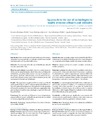Identificador persistente para citar o vincular este elemento:
https://accedacris.ulpgc.es/handle/10553/69385
| Campo DC | Valor | idioma |
|---|---|---|
| dc.contributor.author | Rodríguez-Pulido, Francisco | en_US |
| dc.contributor.author | Rodríguez-Quintero, Laura | en_US |
| dc.contributor.author | Rodríguez-Pulido, Josefa | en_US |
| dc.contributor.author | Rodríguez-García, Ángeles | en_US |
| dc.date.accessioned | 2020-01-25T06:08:21Z | - |
| dc.date.available | 2020-01-25T06:08:21Z | - |
| dc.date.issued | 2019 | en_US |
| dc.identifier.issn | 0120-0011 | en_US |
| dc.identifier.other | Scopus | - |
| dc.identifier.uri | https://accedacris.ulpgc.es/handle/10553/69385 | - |
| dc.description.abstract | Introduction: Given the demands of society in the twenty-first century, information and communication technologies should be incorporated into future models of the public health system. Objective: To investigate about the use of eHealth and mHealth through a quantitative study. Materials and methods: A quantitative study was carried out using a 16-item questionnaire that inquires about 9 dimensions: self-diagnostic technologies, complementation genetic test, use of smartphones, data privacy, electronic medical records, costs of medical services, annual physical examinations, concern about radiation exposure, and management of internet and technologies. Results: The exploratory sample (n=250) was made up of health professionals (55 doctors and 77 medical students) and health service users (122 patients) from Spain. One of the similarities was the promotion of the use of smartphones, but there were differences regarding the value given to diagnosis made by using technologies as opposed to that made by professionals. Conclusion: The most relevant difference in terms of expectations among health service users and health care professionals was related to the ownership of the medical history. | en_US |
| dc.description.abstract | Introducción. Ante los actuales reclamos de la sociedad del siglo XXI, es evidente que las tecnologías de la información y la comunicación deben ser incorporadas en los futuros modelos del sistema sanitario público. Objetivo. Indagar en el uso de e-salud y m-salud a través de un estudio cuantitativo. Materiales y métodos. Se realizó un estudio cuantitativo a través de un cuestionario de 16 ítems orientados hacia 9 dimensiones: tecnologías de autodiagnóstico, pruebas complementarias genéticas, hábito del smartphone, privacidad de datos, historias clínicas electrónicas, costes de servicios médicos, exámenes físicos anuales, preocupación sobre la exposición a radiación y manejo de internet y tecnologías. Resultados. La muestra exploratoria (n=250) estuvo conformada por profesionales sanitarios (55 médicos y 77 estudiantes de medicina) y usuarios del servicio sanitario (122 pacientes) de España. Entre las similitudes se detectó el apoyo al uso del smartphone y entre las diferencias, el valor otorgado al diagnóstico realizado por las tecnologías frente al formalizado por los profesionales. Conclusión. La diferencia más significativa entre usuarios del sistema sanitario y profesionales sanitarios estuvo relacionada con sus expectativas sobre la propiedad de la historia clínica. | en_US |
| dc.language | eng | en_US |
| dc.relation.ispartof | Revista de la Facultad de Medicina, Universidad Nacional de Colombia | en_US |
| dc.source | Revista Facultad de Medicina [ISSN 0120-0011], v. 67 (4), p. 457-462 | en_US |
| dc.subject | 580207 Formación profesional | en_US |
| dc.subject | 32 Ciencias médicas | en_US |
| dc.subject.other | Health Services Accessibility (Mesh) | en_US |
| dc.subject.other | Quality of Health Care | en_US |
| dc.subject.other | Technology | en_US |
| dc.subject.other | Tecnología | en_US |
| dc.subject.other | Gestión de la calidad | en_US |
| dc.subject.other | Accesibilidad a los servicios de salud | en_US |
| dc.title | Approach to the use of technologies in health systems: ehealth and mhealth | en_US |
| dc.title.alternative | Aproximación hacia el uso de las tecnologías en el sistema sanitario: e-salud y m-salud | en_US |
| dc.type | info:eu-repo/semantics/article | en_US |
| dc.type | Article | en_US |
| dc.identifier.doi | 10.15446/revfacmed.v67n4.68850 | en_US |
| dc.identifier.scopus | 85077882669 | - |
| dc.contributor.authorscopusid | 55886017000 | - |
| dc.contributor.authorscopusid | 57213601242 | - |
| dc.contributor.authorscopusid | 57204888960 | - |
| dc.contributor.authorscopusid | 56711369500 | - |
| dc.description.lastpage | 462 | - |
| dc.identifier.issue | 4 | - |
| dc.description.firstpage | 457 | - |
| dc.relation.volume | 67 | - |
| dc.investigacion | Artes y Humanidades | en_US |
| dc.type2 | Artículo | en_US |
| dc.utils.revision | Sí | en_US |
| dc.identifier.ulpgc | Sí | es |
| dc.description.sjr | 0,126 | |
| dc.description.sjrq | Q4 | |
| item.fulltext | Con texto completo | - |
| item.grantfulltext | open | - |
| crisitem.author.dept | GIR Organización, Procesos Educativos y Teoría de la Educación | - |
| crisitem.author.dept | Departamento de Educación | - |
| crisitem.author.orcid | 0000-0003-0195-0801 | - |
| crisitem.author.parentorg | Departamento de Educación | - |
| crisitem.author.fullName | Rodríguez Pulido, Josefa | - |
| Colección: | Artículos | |
Citas SCOPUSTM
3
actualizado el 08-jun-2025
Visitas
141
actualizado el 31-may-2025
Descargas
169
actualizado el 31-may-2025
Google ScholarTM
Verifica
Altmetric
Comparte
Exporta metadatos
Los elementos en ULPGC accedaCRIS están protegidos por derechos de autor con todos los derechos reservados, a menos que se indique lo contrario.
